2015 下半年湖南教师资格高中英语学科知识与教学能力真
题及答案
注意事项:
1.考试时间 120 分钟.满分 150 分。
2.请按规定在答题卡上填涂、作答。在试卷上作答无效,不予评分。
一、单项选择题(本大题共 30 小题,每小题 2 分,共 60 分)
在每小题列出的四个备选项中选择一个最佳答案。请用 28 铅笔把答题卡上对应题目的答案
字母按要求涂黑。错选、多选或未选均无分。
1. In English, the aspirated [ph] and the unaspirated [p] are__________.
A. minimal pairs
B. in phonemic contrast
C. two distinctive phonemes
D. in complementary distribution
2./s/and/θ/can be distinguished by__________.
A. manner of articulation
B. place of articulation
C. vibration of the vocal cords
D. aspiration of articulation
3. You'll find this Travel Guide to be of great __________ in helping you and your
children to get around Malaysia.
A. cost
B. price
C. value
D. expenditure
4. When the train __________, all the school students were surprised to see that
the Carlisle team had one man only.
A. pulled down
B. pulled on
C. pulled off
�
D. pulled in
5. Which of the following words contains an inflectional morpheme?
A. Disappear.
B. Blacken.
C. Oxen.
D. Anti-pollution.
6. Reading is to the mind __________ food is to the body.
A. that
B. which
C. as
D. what
7. He had no time and energy to play with his children or shop with his wife, but
he __________home a regular salary.
A. did bring
B. does bring
C. did get
D. does get
8. In fact, they would rather have left for London __________ in Birmingham.
A. to stay
B. in order to stay
C. than have stayed
D. instead of having stayed
9. __________ makes it possible for language users to overcome the limitations of
time and space in communication.
A. Arbitrariness
B. Duality
C. Productivity
D. Displacement
10. The sense relation of the following pair of sentences is that __________.
X: Mary's pet cat was stolen.
�
Y: Marry has a pet cat.
A. X entails Y
B. X presupposes Y
C. X is inconsistent with Y
D. X is synonymous with Y
11. Which of the following statements about a lesson plan is inappropriate?
A. It is a teaching guide.
B. It is a blueprint to be strictly followed.
C. It takes into account syllabus and students.
D. It describes in advance what and how to teach.
12. Skill-integrated activities allow teachers to build in more __________ into a
lesson, for the range of activities will be wider.
A. certainty
B. simplicity
C. variety
D. accuracy
13. A language proficiency test that only consists of multiple-choice questions
lacks__________.
A. construct validity
B. content validity
C. test reliability
D. scorer reliability
14. When a teacher asks students to rearrange a set of sentences into a logical
paragraph, he/she is trying to draw their attention to__________.
A. grammar
B. vocabulary
C. sentence patterns
D. textual coherence
15. Which of the following activities would help students develop the skill of
extracting specific information?
�
A. Inferring meaning from the context.
B. Recognizing the author' s beliefs and attitudes.
C. Using information in the reading passage to make hypotheses.
D. Listening to the flight information to see if the plane is on time.
16. Which of the following activities can be used to check students' understanding
of difficult sentences in the text?
A. Paraphrasing.
B. Blank-filling.
C. Story-telling.
D. Summarizing.
17. When a teacher organizes group work, which of the following might be of the least
con-cern?
A. Increasing peer interaction.
B. Increasing individual practice.
C. Developing language accuracy.
D. Providing variety and dynamics.
18. If a teacher asks students to collect, compare and analyze certain sentence
patterns, he/she aims at developing students'__________.
A. discourse awareness
B. cultural awareness
C. strategic competence
D. linguistic competence
19. When a teacher says to the whole class, "Stand up and act out the dialogue",
he/she is playing the role of a(n) __________.
A. monitor
B. organizer
C. assessor
D. prompter
20. Which of the following may better check students' ability of using a grammatical
structure?
�
A. Having them work out the rule.
B. Having them give some examples.
C. Having them explain the meaning.
D. Having them explain the structure.
请阅读 Passage l,完成第 21-25 题。
Passage 1
When asked by Conan if his daughters had smart phones, comedian Louis CK explained
that he had successfully fended them off by simply replying, "No, you can't have
it. It is bad for you."
He instantly became my hero as I was mired in difficult negotiations with my
ten-year-old daughter over one. And frankly, she was winning. Was it possible to
say no to my daughter, as CK suggested? I hadn't even known I was allowed to, if
the guinea pigs, the dogs, and things for her doll Molly were any indication. CK
rationalized,"I am not raising the children. I'm raising the grown-ups that they
are going to be. So just because the other stupid kids have phones doesn't mean that
my kid has to be stupid." Now I knew I didn't want my kid to grow up stupid like
her friends. I needed to explain this to her. This is what CK told Conan and me.
Cell phones are "toxic, especially for kids," he said, because they don't help them
learn empa-thy, one of the nicer human emotions. When we text, we don' t see or hear
a visceral reaction. The response we get is cold and hard text-message. "Why are
kids mean?" He asked. "Because they're trying it out. They look at another kid and
say,' You' re fat.' Then they see the kid' s face scrunch up and think that doesn't
feel good." Texting "you're fat" allows you to bypass the pain.
CK went on to explain that smart phones rob us of our ability to be alone. Kids use
smart phones to occupy their time: Must text! Must play game! Must look up more tiny
socks online for Molly!!! CK asked, what happened to zoning out? After all, one of
the joys of being human is allowing our minds to wander, with cell phones, kids are
always preoccupied. They never daydream, except in class. And here' s something else
we' re missing: our right to be miserable. This was a fight I hadn' t realized I
desired until CK pointed out that it' s another essential human emotion.
�
CK gave the example of driving by yourself and suddenly reali:,ing that you're alone.
Not "Oh, guess I can't use the lane" alone. Dark, brooding sadness causes so many
drivers to grab that smart phone and reach out to another living soul.
"Everybody's murdering each other with their cars" as they text because they dread
being alone. Too bad--they're missing out on a life-affirming experience.
"I was in my car one time, and Bruce Springsteen's'Jungle land' came on. He sounds
so far away, making me really sad. And I think I've got to get the phone and write
hi to 50 people. I was reaching for the phone, and I thought, don't! Just be sad."
So CK pulled over and allowed himself to sob like a little girl denied a nice thing
for her Ameri-can Girl doll. "It was beautiful. Sadness is poetic. You're lucky to
live sad moments," he said. Be-cause he didn't fight it and allowed himself to be
miserable, his body released endorphins. "Happi-ness rushed in to meet the sadness.
I was grateful to feel sad, and then I met it with true profound happiness. The thing
is, because we don' t want that first bit of sad, we push it away with that little
phone. So you never feel completely sad or completely happy. You just feel kind of
satisfied. And then you die. That' s why I don' t want to get phones for my kids".
And I suppose I don't either.
21. Why did the author regard CK as her hero?
A.CK was a good father and a very brave comedian in her eyes.
B.CK didn' t agree to buy smart phones for his young daughters.
C. She was very impressed by his solution to the smart phone problem.
D. She was encouraged by him not to make any compromises to her daughter.
22. What does the underlined word "one" in PARAGRAPH TWO refer to?
A. A dog.
B. A doll.
C. A guinea pig.
D. A smart phone.
23. Why did CK refuse to buy his kids cell phones?
A. He didn't like cell phones at all and thought they were poisonous, especially,
for kids.
�
B. He believed that cell phones were ruining kids' abilities to experience their
own lives.
C. He worried that his kids would play their phones in class and be absent-minded.
D. He was a different kind of father who would like to raise his kids in a different
way.
24. Which of the following is closest in meaning to the underlined phrase "zoning
out" in PARAGRAPH FOUR?
A. Losing concentration.
B. Being alone.
C. Buying things on line.
D. Playing games.
25. Which of the following is true according to the article?
A. Text messages have allowed children to learn and feel empathy.
B. Cell phones have made children' s life at school colorful and exciting.
C. Experiencing loneliness or sadness is as beneficial as enjoying happiness.
D. Cell phones may offer people the quickest way to find someone to talk to.
请阅读 Passage 2,完成第 26-30 题。
Passage 2
Until a decade or two ago, the centers of many Western cities were emptying while
their edges were spreading. This was not for the reasons normally cited. Neither
the car nor the motorway caused suburban sprawl, although they sped it up: cities
were spreading before either came along.
Nor was the flight to the suburbs caused by racism. Whites fled inner-city
neighborhoods that were becoming black, but they also fled ones that were not.
Planning and zoning rules encouraged sprawl,as did tax breaks for home
ownership--but cities spread regardless of these. The real cause was mass affluence.
As people grew richer, they demanded more privacy and space. Only a few could af-ford
that in city centers; the rest moved out.
The same process is now occurring in the developing world, but much more quickly.
The popu-lation density of metropolitan Beijing has collapsed since 1970, falling
�
from 425 people per hectare to 65. Indian cities are following; Brazil's are ahead.
And suburbanization has a long way to run.
Beijing is now about as crowded as metropolitan Chicago was at its most closely packed,
in the1920s. Since then Chicago' s density has fallen by almost three-quarters.
This is welcome. Romantic notions of sociable, high-density living--notions pushed,
for themost part, by people who themselves occupy rather spacious residences--ignore
the squalor and lack of privacy to be found in Kinshasa, Mumbai or the other crowded
cities of the poor world. Many of them are far too dense for dignified living, and
need to spread out.
The Western suburbs to which so many aspire are healthier than their detractors say.
The mod-em Stepfords are no longer white monocultures, but that is progress. For
every Ferguson there are many American suburbs that have quietly become black,
Hispanic or Asian, or a blend of everyone.
Picaresque accounts of decay overlook the fact that America' s suburbs are half as
criminal and a lit-tle more than half as poor as central cities. Even as urban centers
revive, more Americans move from city centre to suburb than go the other way.
But the West has also made mistakes, from which the rest of the world can learn.
The first les-son is that suburban sprawl imposes costs on everyone. Suburbanites
tend to use more roads and consume more carbon than urbanites (though perhaps not
as much as distant commuters forced out by green belts). But this damage can be
alleviated by a carbon tax, by toll roads and by charging for parking. Many cities
in the emerging world have followed the foolish American practice of requiring
property developers to provide a certain number of parking spaces for every building
—something that makes commuting by car much more attractive than it would be
otherwise. Scrap ping them would give public transport a chance.
The second is that it is foolish to try to stop the spread of suburbs. Green belts,
the most effec-tive method for doing this, push up property prices and encourage
long-distance commuting. The cost of housing in London, already astronomical, went
up by 19% in the past year, reflecting not just the city' s strong economy but also
the impossibility of building on its edges. The insistence on big minimum lot sizes
�
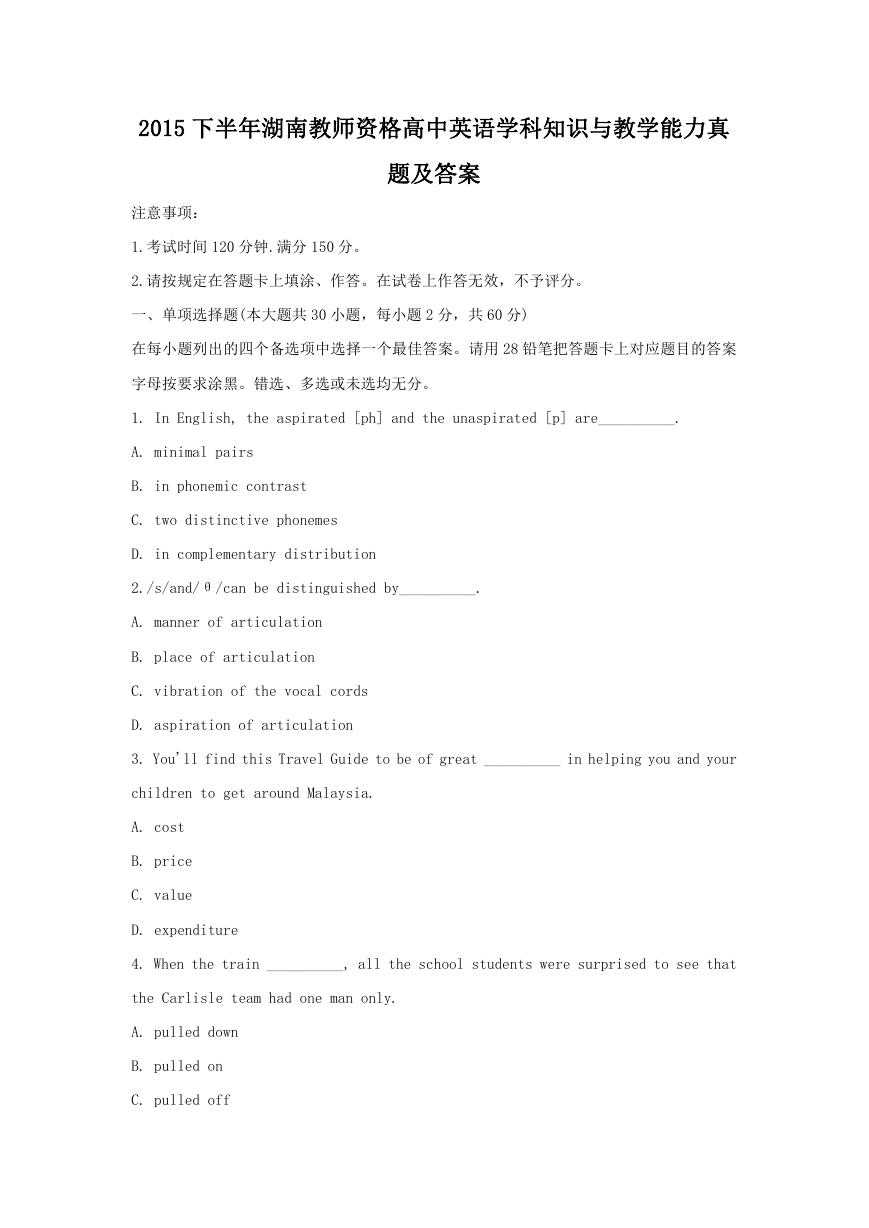

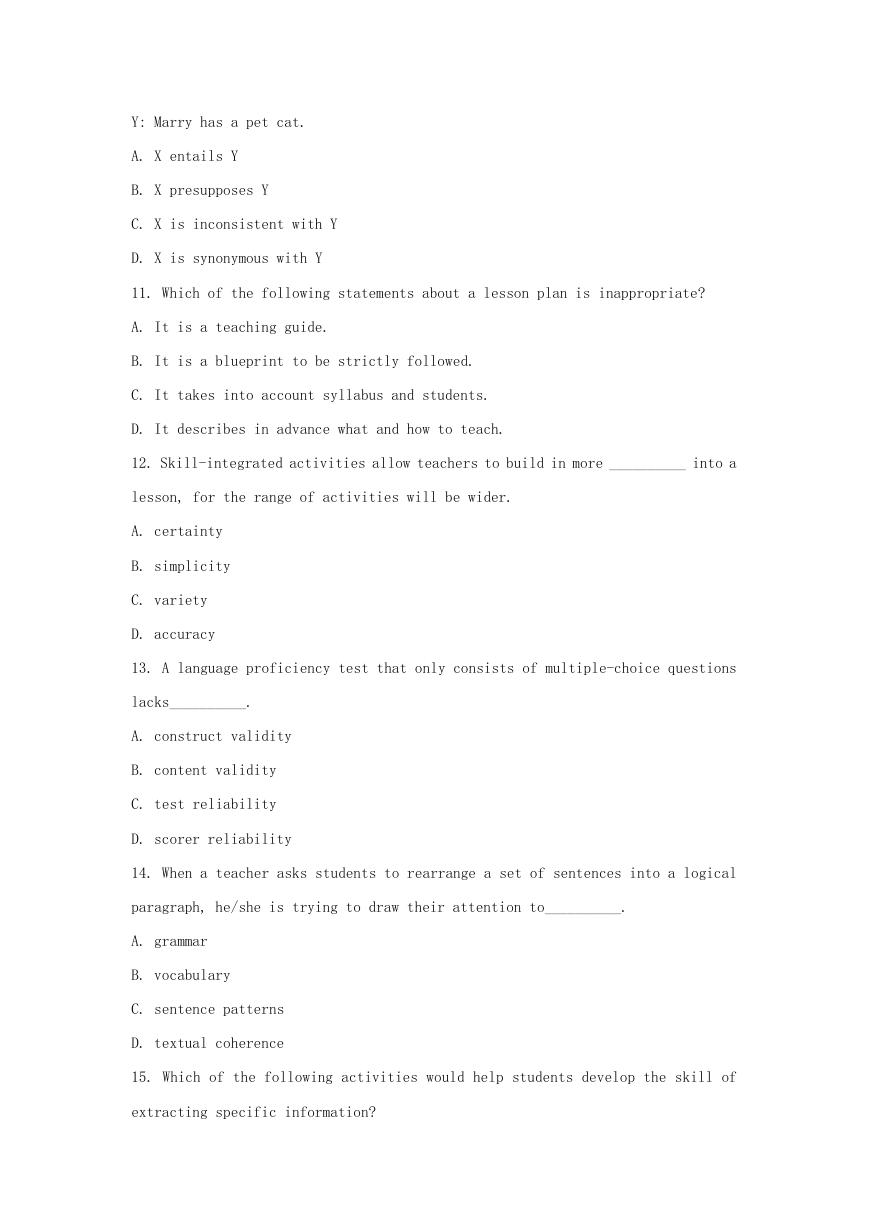
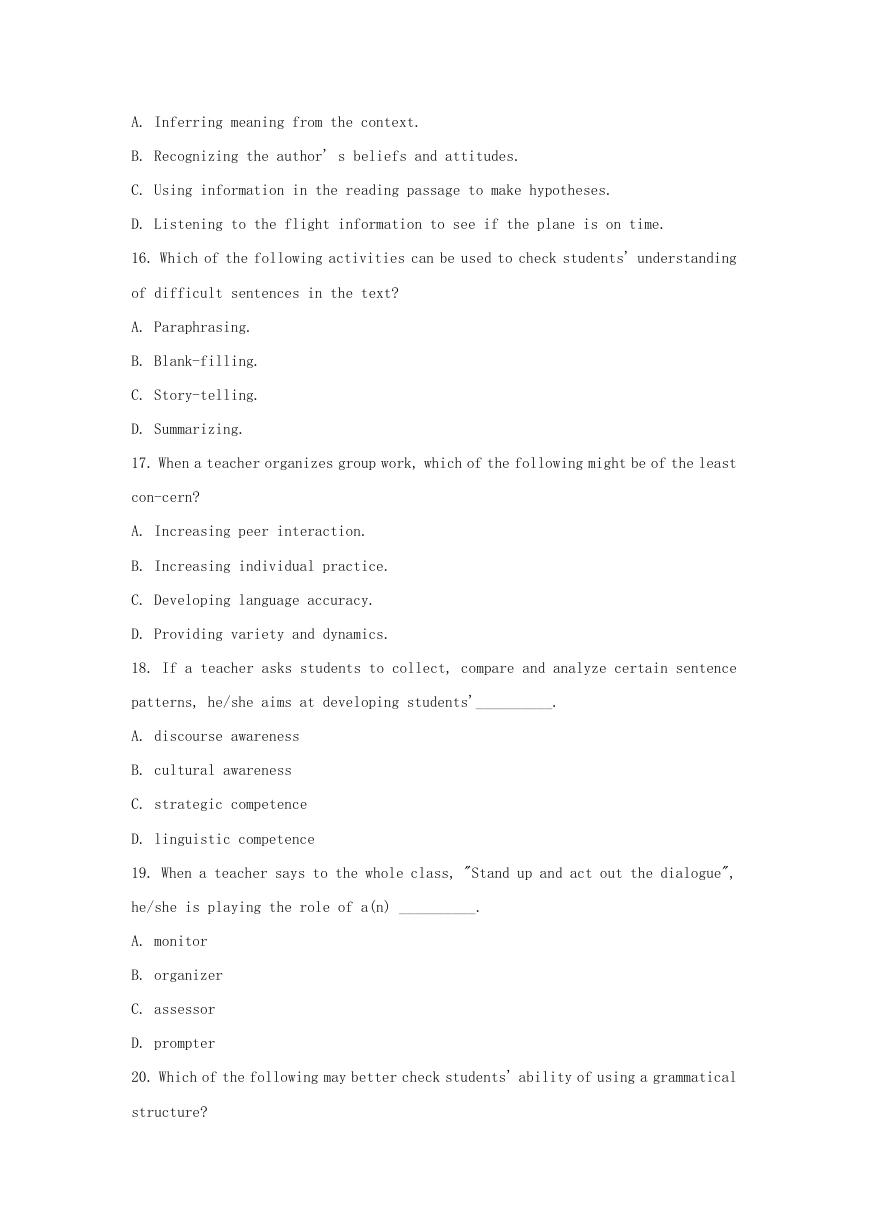
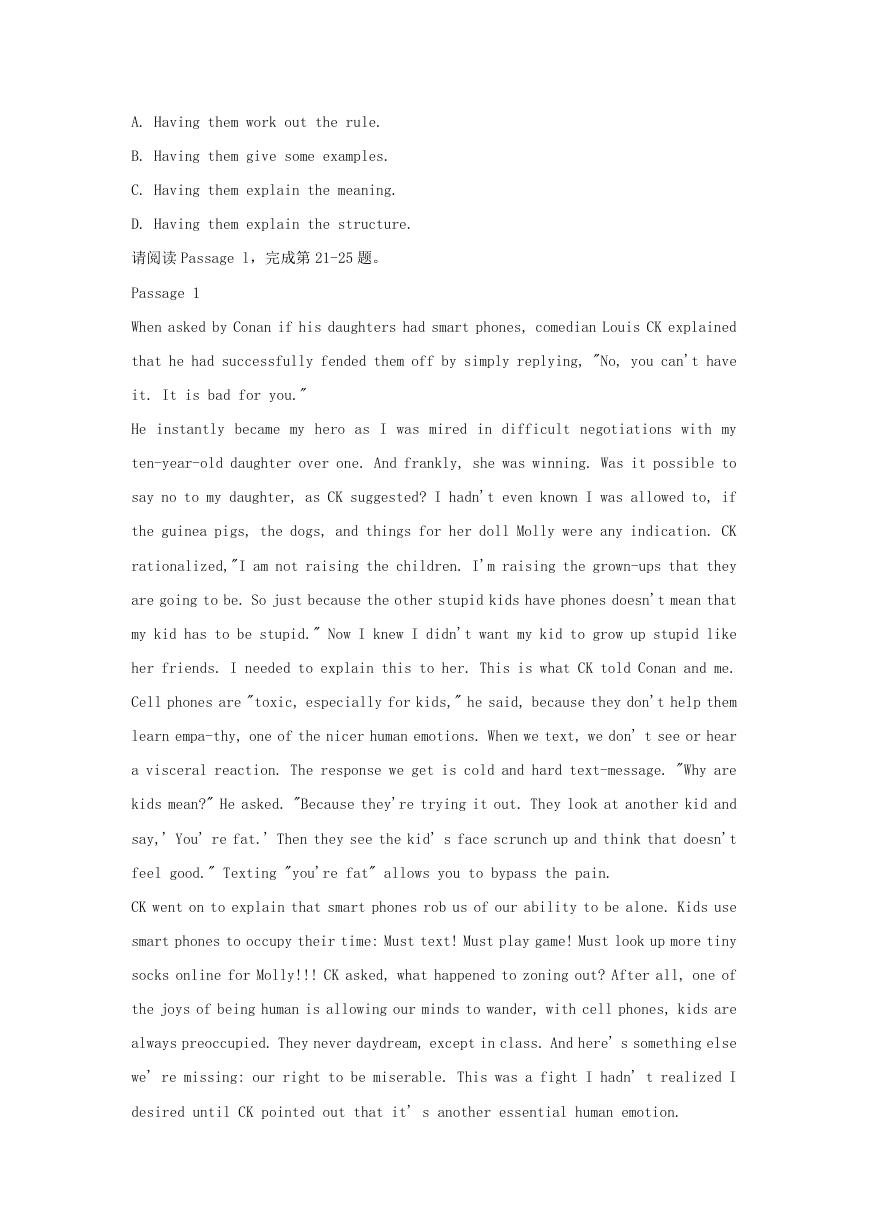

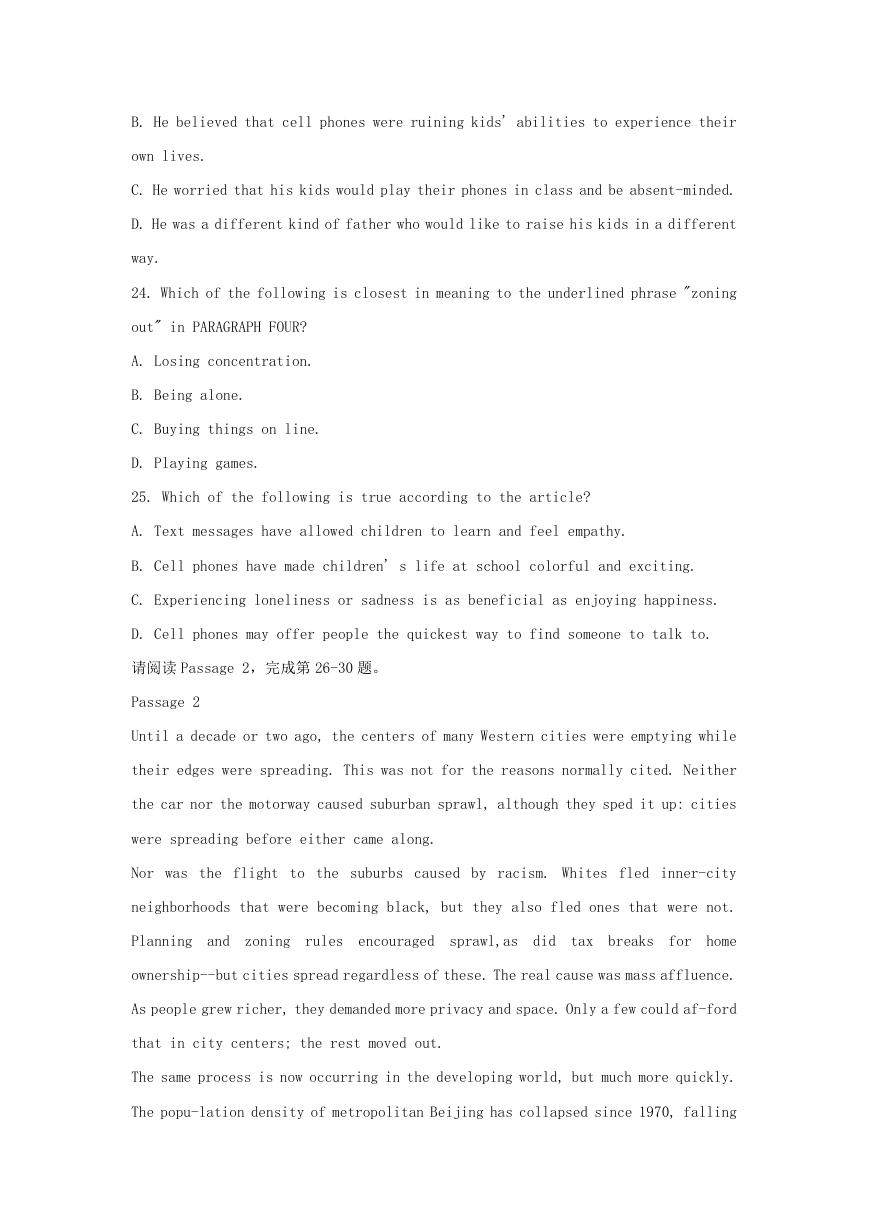
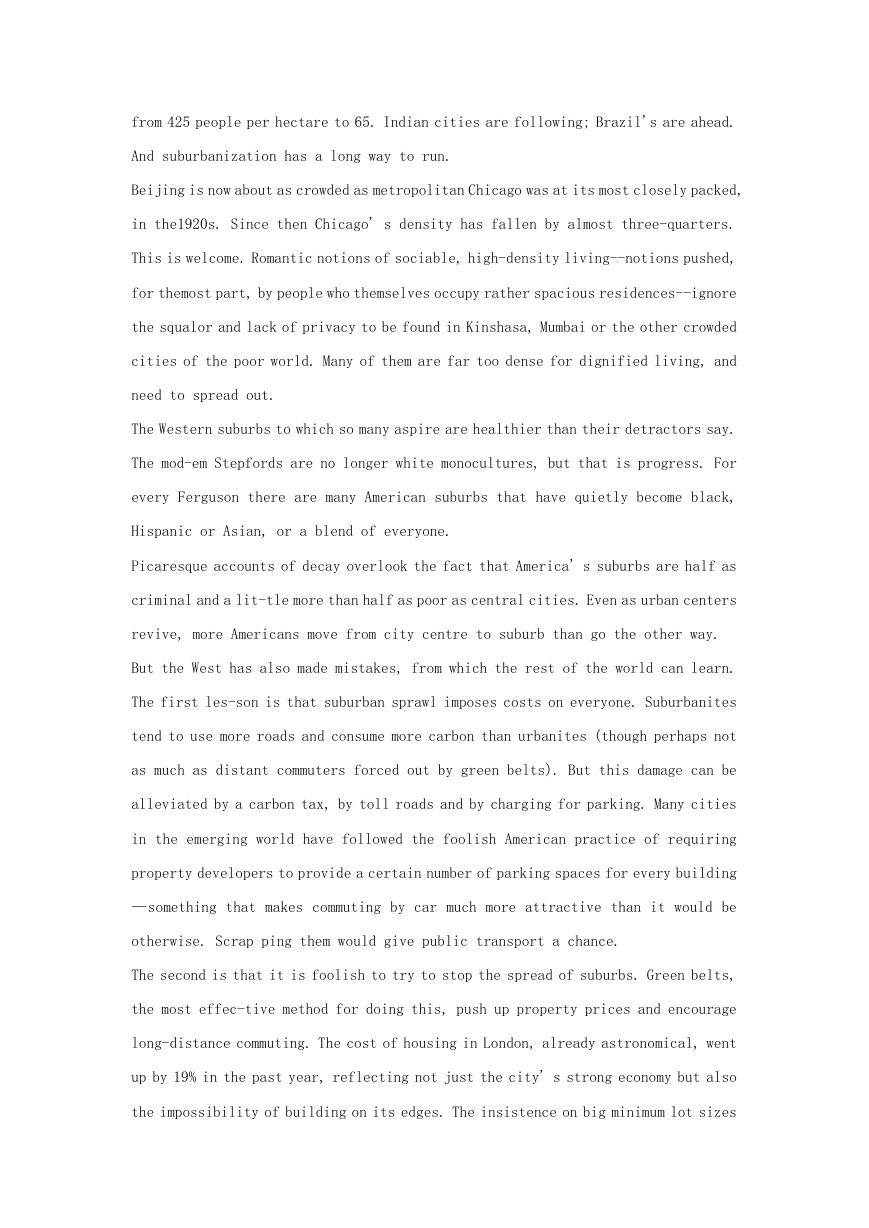








 2023年江西萍乡中考道德与法治真题及答案.doc
2023年江西萍乡中考道德与法治真题及答案.doc 2012年重庆南川中考生物真题及答案.doc
2012年重庆南川中考生物真题及答案.doc 2013年江西师范大学地理学综合及文艺理论基础考研真题.doc
2013年江西师范大学地理学综合及文艺理论基础考研真题.doc 2020年四川甘孜小升初语文真题及答案I卷.doc
2020年四川甘孜小升初语文真题及答案I卷.doc 2020年注册岩土工程师专业基础考试真题及答案.doc
2020年注册岩土工程师专业基础考试真题及答案.doc 2023-2024学年福建省厦门市九年级上学期数学月考试题及答案.doc
2023-2024学年福建省厦门市九年级上学期数学月考试题及答案.doc 2021-2022学年辽宁省沈阳市大东区九年级上学期语文期末试题及答案.doc
2021-2022学年辽宁省沈阳市大东区九年级上学期语文期末试题及答案.doc 2022-2023学年北京东城区初三第一学期物理期末试卷及答案.doc
2022-2023学年北京东城区初三第一学期物理期末试卷及答案.doc 2018上半年江西教师资格初中地理学科知识与教学能力真题及答案.doc
2018上半年江西教师资格初中地理学科知识与教学能力真题及答案.doc 2012年河北国家公务员申论考试真题及答案-省级.doc
2012年河北国家公务员申论考试真题及答案-省级.doc 2020-2021学年江苏省扬州市江都区邵樊片九年级上学期数学第一次质量检测试题及答案.doc
2020-2021学年江苏省扬州市江都区邵樊片九年级上学期数学第一次质量检测试题及答案.doc 2022下半年黑龙江教师资格证中学综合素质真题及答案.doc
2022下半年黑龙江教师资格证中学综合素质真题及答案.doc